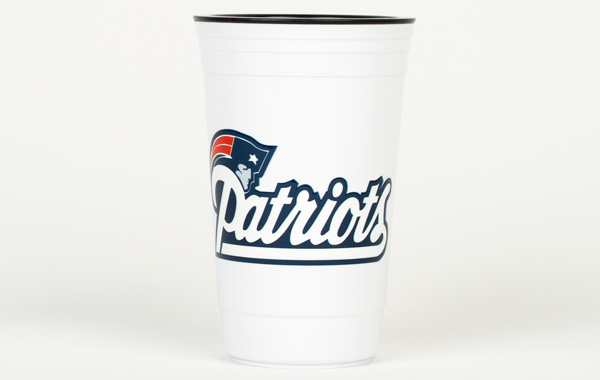- Equipment
- Inks & Supplies
- Services
- Applications
- Tagless
- Resources
- About Us
- Contact Us

Stop and take in your surroundings at this moment. How many plastic items are within reach? How many of them are decorated or branded? Whether you’re at your desk at work, your home office, in your car, or in your local coffee shop… chances are numerous types of decorated plastics surround you.
In total there are seven different types of plastic: Polyethylene Terephthalate (PETE or PET), High-Density Polyethylene, Polyvinyl Chloride, Low-Density Polyethylene, Polypropylene, Polystyrene or Styrofoam, and the seventh category that includes miscellaneous plastics like polycarbonate, acrylic, styrene, fiberglass, nylon, and polylactide. The many types of plastic available create a magnitude of options when it comes to manufacturing items. These items, whether it’s a notebook, car part, or reusable iced coffee cup dazzle with UV printing on plastic. Stunning, high quality, full color graphics can be achieved on plastic easily with a UV flatbed printer or digital cylindrical printer.
UV printing on plastic requires a pre-treatment to ensure optimal adhesion. But, what is optimal adhesion? Optimal adhesion is said to hold true if the contacting surfaces perfectly conform to each other. In other words, the substrates’ surface and ink form an irreversible bond. Adhesion itself is measured in bond strength.
For this reason, Inkcups offers adhesion testing. Adhesion testing ensures that the correct method(s) of pre-treatment and correct ink is applied to the substrate through ASTM’s four standardized tests. Tape, scratch, Crosshatch A, and Crosshatch B make up the four different tests, more commonly used for glassware. However, flexible bottle and ice bucket testing are additional adhesion test geared toward testing adhesion on flexible plastics, like sports bottles.
Before UV printing on plastics, one must pre-treat. The level of pre-treatment is dependent on the intended life of the product. For instance, if substrate is for promotional purposes the adhesion standards are much less than that of drinkware. Additionally, if you’re UV printing on plastics that can be printed on with a UV flatbed printer, adhesion quality to last through dish washes does not align with your needs.
It goes without saying that these days we expect our drinkware to be dishwasher safe. Busy lives leave little time for hand washing dishes, any down time will not willingly be spent at a sink. Properly pre-treat plastic drinkware vessels first with a primer wipe, then with either a flame, corona, or plasma pre-treatment. To better understand the difference between the additional methods of pre-treatment, visit another blog post UV Ink Adhesion Improvement Components.
The average promotional product is kept for five months. That being said, the quality of promotional products range greatly and because of this a primer wipe alone will satisfy the needs of the products lifespan.
Digitally print on plastics with a flatbed printer such as the X5® and pre-treat with a primer wipe. Inkcups offers four primers specifically for plastic; XF Primer, S Primer, PP Primer, and PL Primer. All are great options for promoting adhesion. For example, the PP Primer reduces the surface tension on Polypropylene and Polyethylene products for a better bond.
More companies are opting for plastic drinkware made from Tritan plastic as it is known as the safest plastic available in the world. Tritan is BPA-free, and also free from BPS and all other bisphenols. BPA, Bisphenol A is a chemical compound that is an endocrine disruptor and xenoestrogen, with studies showing that BPA is associated with affecting children’s behavior and various other health risks later in life.
Tritan plastic is typically a difficult plastic to adhere ink to without an extensive pre-treatment process. However, UV print on Tritan plastic products with any of the Inkcups’ cylindrical or flatbed printers with T2 UV Ink and skip a pre-treatment process. T2 UV ink is available in Cyan, Magenta, Yellow, Black, White, and Varnish to create vibrant graphics with excellent adhesion and high abrasion resistance.
Once the pre-treatment method has been identified that best aligns with your adhesion goals, you can explore UV ink options. For printing on plastic, Inkcups has a four different ink lines available. As previously mentioned, the T2 UV ink is specially formulated for printing on Tritan plastic without any pre-treatment. Other UV inks for plastics include the S1 UV Inkjet ink, XFlexx, and BB Ultra Flexible UV ink.
Whether you wish to print on plastic for promotional, industrial or drinkware industries, Inkcups has a printing machine to suit the requirements. Inkcups has different offerings in three main categories: flatbed, conveyorized and cylindrical inkjet printers. A UV inkjet printer loaded with UV ink uses ultraviolet light to instantly cure the ink once print heads lay down tiny droplets of CMYK ink.
A popular plastic cup found at sporting events, theme parks and vacation bars alike are stadium cups. Stadium cups are commonly food-grade, medium to heavy plastic and widely used as souvenirs for a variety of industries. These cups are distinguishable from other plastic cups as they often have a short rim around the top of the vessel.
Due to stadium cups lightweight nature and large volume printing quantities, stadium cups make for an excellent application for printing with the Revolution®. Currently, it is the highest speed cylindrical printer in the Helix® line. The Revolution® can both pre-treat and print up to 600 parts per hour. Additionally, the Revolution® comes standard with automatic load and unload, perfect for stadium cups which can be easily unloaded into a cardboard box for shipment. As stadium cups are often used long after the initial event it is important to pre-treat. With integrated corona or plasma treatment customers will be pleased with the longevity of graphics on their stadium cup for many dishwasher cycles to come.
To get in touch with the sales representative in your area, contact us today.
Back to Blog Home
Add Your Comment